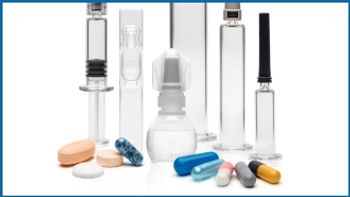
- Pharmaceutical Technology-11-01-2008
- Volume 2008 Supplement
- Issue 6
Freeze-Drying with Closed Vials
The authors present an aseptic-filling process for freeze-dried liquids using the closed-vial technology.
Thilly and coauthors introduced closed-vial filling systems, called "Crystal" technology, for aseptic filling of liquid products in Pharmaceutical Technology's 2005 Aseptic Processing supplement (1). Aseptic Technologies (Gembloux, Belgium) has now taken closed-vial technology a step further by developing a process using the closed vial for lyophilization. The technology consists of using ready-to-fill, gamma-sterilized, closed vials and filling them using a needle passing through the stoppper, followed by a laser resealing to restore the closure integrity. The vial body, made of cyclo-olefin copolymer (COC), rather than glass, and the stopper, made of thermoplastic elastomer (TPE), are injection molded and assembled by robots in an ISO 5 (Class 100/Grade A) environment.
The process involves securing the closure integrity with a top ring, and then gamma-irradiating the vial to ensure sterility. The closed vial is then determined to be clean on the inside and sterile and therefore ready for filling. Plastic molding of vial elements allows the vial to have specific functionalities such as an optimized stopper shape and fully secured closure integrity (2).
In the filling line, the TPE stopper is pierced by a special filling needle. Immediate self-reclosing takes place at the needle withdrawal and the piercing trace is resealed with a noncontact laser beam, restoring a continuous upper surface of the stopper. Overpressure inside the vial during filling is eliminated by venting grooves in the outer surface of the needle shaft. A sterile plastic cap is then snapfitted on top of the stopper, which is still inside the barrier. The special cap design protects the piercing target until use by a healthcare professional (1, 2).
Because the container is permanently closed, the entire process from vial manufacturing to liquid filling benefits patients by optimizing sterility assurance (see Figure 1). Pharmaceutical manufacturers also benefit from the simplicity of the filling operation compared with the classical but complex glass-vial filling process. This article describes the concept and process of closed-vial, freeze-drying technology in more detail.
Figure 1: Closed vial process: Vial bodies and stopper are molded in ISO 5 (Class 100/Grade A) environment and immediately assembled by robot before the top and bottom rings are added; after packaging, the vials are gamma-irradiated; at the pharmaceutical site, vials are filled with a needle passing through the stopper, which is then laser resealed; and finally, capping is completed. (ALL FIGURES ARE COURTESY OF THE AUTHORS.)
The closed-vial, freeze-drying concept
To maintain optimal sterility assurance, an opening in the vial is required but has been limited in this particular process. The vial actually remains closed most of time, especially between the filling station and the freeze dryer's shelf. The opening and closing of the vial is generated by rearranging the movements of the freeze-dryer shelves. When the cycle is finished, the vial closes again before the freeze dryer's door is opened and stays closed until the vial is resealed with a laser and capped. This process has several advantages over traditional glass-vial processing:
- The closed vial content is not exposed during its movement from the sterilization tunnel to the freeze dryer (no half-seated stopper).
- There is no risk of product spillage on the vial track to the freeze dryer or on the shelves themselves. Moreover, the plastic vials are shock resistant and nearly unbreakable.
- The stoppers do not stick to the upper shelf.
- There is no risk of incomplete reseating of the stopper or stopper pop-up after the stoppering step; closure integrity is maintained throughout the process.
- When required, this process has the capability of inspecting for particles of the liquid before freeze-drying, provided that the inspection machine is compliant with a Class 100 environment. The vial's bottom ring enables it to be held from the bottom only for the rotation, without an upper spindle above the vial. Its slightly elevated bottom allows for a perfect view on the critical bottom part of the content.
The system and process in detail
The system. A small, disposable device called the penetrator reopens the piercing trace made by the filling needle. This penetrator is installed on top of a regular closed vial by a light snapfit over its existing top ring. Made of medical-grade, high-density polyethylene (HDPE), the penetrator is gamma-irradiated to avoid contamination during lyophilization. The penetrator has an internal cone with an open tip located above the piercing spot.
Vertical downward movement of the freeze-dryer shelf, carried out before the freezing phase, pushes the penetrators down. At the same time, the front ring of the open tip pushes (but does not pierce) the surface surrounding the piercing trace. This push reopens the piercing trace and generates a passage for the water vapor during freeze-drying. The size of the cone's pushing front ring on the penetrator is large enough and tolerant enough to accommodate the needle piercing.
Shelves are kept down during the three lyophilization phases (freezing, sublimation, and secondary drying) to keep the stopper open and allow gas to exit. At the end of the secondary drying phase, when temperature is back in the 25–35 °C range, the shelves are lifted to their initial position. The resilience of the deformed stopper push up the penetrators while the stopper opening recloses and reseals itself.
The process. The entire process can be separated into three steps: vial-filling, lyophilization, and vial-closing and capping (see Figure 1). Each is described below.
The vial-filling step is identical to the classical filling process described by Verjans et al. and Thilly et al. (1, 2). The same vial is loaded on the filling equipment and the vial is filled by a needle piercing through the stopper. The only modification is that the needle has a slightly larger diameter (11G gauge instead of 13G) and its tip configuration is trocar, giving a precise cut in the elastomer, with the shape of a three-branch star. These two features facilitate future reopening of the stopper. As with liquid-filling needles, the stopper's elasticity allows it to immediately self-reclose after filling. After filling, the process changes radically as the immediate laser resealing and capping are eliminated and replaced by the positioning of the penetrator on top of the vial with a placement tool (see Figure 2, positions 1 and 2). The vial, still closed, is then conveyed to the freeze dryer's loading unit and onto the shelves (see Figure 2, position 3).
Figure 2: Lyophilization process: (1) A vial and the penetrator, (2) penetrators are placed on the vial with a placement tool, (3) vials are introduced inside the lyophilization unit and the shelves are moved down to break the bridges, (4) the shelf reopens the piercing trace to allow lyophilization, (5) the shelf is moved up, and (6) the penetrator is withdrawn. (ALL FIGURES ARE COURTESY OF THE AUTHORS.)
After classical freeze-dryer loading and once the door is closed, the shelves move down, pushing on the penetrators located above the closed stoppers. The penetrator is molded as one piece but has two subcomponents linked with six breakable bridges (see Figure 3). The subcomponents are:
Figure 3: Penetrator with cone attached to the base with small breakable bridges. Once these bridges are broken by the vertical movement of the shelves, the cone slides inside the base. (ALL FIGURES ARE COURTESY OF THE AUTHORS.)
- A cylinder base that ensures the holding (by light snapfit) on the top ring and its adequate centering.
- A cone that can slide inside the base when the shelf is pushing. Three large side openings in the upper part of the cone enable gas passage between the cone and shelf.
As the shelf moves down at constant speed, the six bridges are broken (taking about 25 to 30 N/vial), releasing the cone for further pushing work on the stopper. At the end of the downward stroke of the shelves, the front tip of the cone pushes on the stopper around the pierced spot, without penetrating the stopper. By radial elastomeric expansion, the cone reopens the piercing trace and the lyophilization cycle can begin (see Figure 2, position 4). The opening cross-section of the stopper is adequate to allow vapor exit (as tested in fast cycles and with sucrose 10%). The reopening of the piercing trace requires about 45 N/vial, slightly below the classical stoppering pressure needed for glass vials (industrial freeze dryers are classically calculated for a minimum of 10 tons/m2 of stoppering pressure). During the entire cycle, shelves are kept in that low position, keeping the stoppers open.
At the end of the cycle, as the temperature rises above 25 °C, the stopper fully recovers its elastomeric resilience. When the shelves are lifted, the stopper takes its original shape, lifts the penetrator cone back on top of itself and self-reseals (see Figure 2, position 5). This happens even during long lyophilization cycles (e.g., three days).
After exiting the freeze dryer's chamber under barrier conditions, the penetrators need to be removed. This step is easily achieved because the penetrators are linked to the vial with three very light snapfits. A passage of the vial along a fixed side-cam finger is sufficient to withdraw the penetrator (see Figure 2, position 6). At that time, the vial is ready for laser and capping.
Laser resealing is performed using a 6 mm-diameter laser spot which ensures proper cover of the piercing area. Finally, capping is completed as usual. These last three steps are performed under an ISO 5 (Class 100/Grade A) environment to avoid contamination before laser-resealing. This environment also ensures asepsis of the stopper top surface as it remains protected against contamination until use.
Packaging
It is recognized that water still present in washed, steam-sterilized stoppers after a lyophilization cycle can cause a 1% elevation of moisture content during shelf-life in glass vials. However, with closed vials, this problem does not occur because the stopper processing does use water.
Despite the fact that the plastics used in the Crystal vial (COC and TPE) have low water-vapor transmission rate (WVTR), they do not warrant the high protection required for keeping freeze-dried cakes in a low-percentage humidity range during full shelf-life (e.g., as recommended by World Health Organization). Therefore, additional barriers against moisture ingress should be obtained and can be easily achieved with adequate secondary packaging (e.g., an aluminum pouch [pinhole-free Al thickness of 20 µm, within a multilayer film] or a blister cavity with aluminum lidding and a low WVTR transparent thermoformable film [polyvinylidene chloride multilayers have very low WVTR]).
Process qualification
To ensure that Crystal technology is suitable for lyophilization, several tests have been conducted using various products, quantities, and conditions. For example, the authors:
- Used various excipients to investigate lyophilization feasibility: qualification started with an easily lyophilized excipient (lactose 5%) and finished with a complex one (glass transition point below –38 °C).
- Increased vial quantities per lyophilization cycle: starting with a few vials and using glass vials as a control, lyophilization cycles were made with up to 720 vials placed on two shelves (see Figure 4).
- Used sensitive products to assess the quality of the lyophilization process for the product. (Living viruses that are particularly sensitive to lyophilization have been used to assess the recovery after lyophilization).
Figure 4: Lyophilization unit loaded with closed vials; lyophilized products inside closed vials. (ALL FIGURES ARE COURTESY OF THE AUTHORS.)
All tests were performed in a Christ Epsilon 2.25 D freeze dryer with seven shelves and an industrial controlling system, using 2-mL closed vials (22.25-mm diameter) and penetrators molded in high-density polyethylene, from a two-cavity mold.
Closure integrity after laser resealing has been tested, as has effective protection of the plastic cap. The following aspects were observed and analyzed for most cycles:
- Correct lift-back of pushers at time of shelf's upward movement at the end of the cycle.
- Quality of the closure integrity after resealing.
- Humidity content of cakes (target is 1%, +/- 0.2%).
- Visual aspect of cakes.
- For viruses, content titer was measured at cycle end and after accelerated aging (seven days at 37 °C), compared with lyophilized glass vials. In some cycles, temperature was recorded with probes installed in plastic vials and in control glass vials to analyze temperature curves.
The outcomes of these tests were:
- Closed vials and their closure integrity remain unaffected after undergoing temperature and pressure cycles of a freeze-drying cycle.
- Plastic material and elevated bottom of the vial are not deterrent to effective energy transfers. It is likely that the combination of a continuous pressure over the vial top applied by the upper shelf during the complete cycle and a perfectly flat vial bottom help the contact between the vial and the shelves and therefore the conductive part of the heat exchange process.
- Cycle is extended by 20 min during the first phase of freezing, right after the change of phase and temperature uplift. However, the same terminal temperature (–55 °C) is reached in the same manner at the end of the freezing phase.
- All tests are successful even for most complex excipients when similar cycles are used compared with a glass vial (2-mL vial).
- Highly sensitive viruses are recovered with similar titers in Crystal and glass vials when both are being processed together in the same cycle.
- To ensure that the vial is effectively self-resealed after the cycle, high negative pressure inside the vial at exit of the chamber is not recommended.
Conclusion
The ready-to-fill closed vial used for liquid products is suitable for freeze-drying without modification. It also holds substantial containment and functional advantages over the glass vial. This vial is suitable for classical freeze dryers with minimal impact on cycles. Even though the quality of the lyophilized product in a ready-to-fill closed vial remains at same level as a lyophilized product in a glass vial, the ready-to-fill closed vial process is easier and product sterility assurance is at a higher level. Useful for all kinds of products, freeze-drying in a plastic, closed vial brings additional definitive benefits to both the patient, the healthcare specialist, and the manufacturer when product containment is mandatory such as with cytotoxic and biohazard products.
References
1. B. Verjans, J. Thilly, and C. Vandecasserie, "A New Concept in Aseptic Filling: Closed-Vial Technology," Pharm. Technol., Aseptic Processing supplement, s24–s29 (2005).
2. J. Thilly, D. Conrad, and C. Vandecasserie, "Aseptic Filling of Closed, Ready-to-Fill Containers," Pharm. Eng., 26 (2), 66–74 (2006).
Acknowledgments
The authors would like to thank Romain Veillon at Glaxo-SmithKline Biologicals for his supportive contribution to the experimental tests as well as his technical expertise and advice. Aseptic Technologies benefits from grants from the Walloon Region and the Agence Wallone à L'Exportation (AWEX). Core closed-vial technology has been licensed by Medical Instill Technologies.
Jacques Thilly* is director of research and development at Aseptic Technologies, Rue Camille Hubert 7-9, B-5032 Gembloux, Belgium, tel. +32 81 409 413, fax +32 81 409 411,
*To whom all correspondence should be addressed.
Articles in this issue
about 17 years ago
Manufacturing High-Potency Drugs Using Isolatorsabout 17 years ago
Guidelines for Selecting Normal Flow Filtersabout 17 years ago
Considerations on Re-Use of Sterilizing-Grade FiltersNewsletter
Get the essential updates shaping the future of pharma manufacturing and compliance—subscribe today to Pharmaceutical Technology and never miss a breakthrough.





